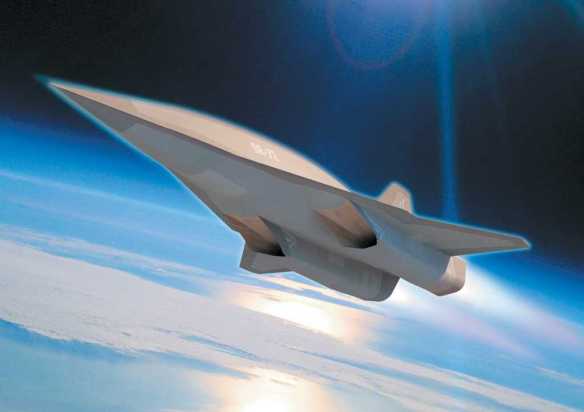Lockheed SR-72 concept rendering.
The final curtain call for the SR-71 was long and complex. Although decommissioned in 1990, it served as a flight-research platform for NASA until 1997. The US Congress voted in 1994 to reactivate three SR-71s for the air force. The final USAF flight occurred in 1997, and in 1999 NASA made a last flyover during its annual Edwards AFB open house.
But public interest in secret, high-altitude, high-speed aircraft refused to die with the SR-71. Even before the Blackbird left the tarmac for good, media reports speculated whether strange sounds and contrails in the skies over the western US meant that American military and intelligence services had developed a successor aircraft, known by the codename Aurora.
Whether Aurora existed or not, in November 2013 the Lockheed Martin Skunk Works unveiled to Aviation Week and Space Technology a plan for a next-generation SR-71. In releasing its concept, Lockheed pinpointed the specific role of a demonstrator that it called the SR-72: an armed, hypersonic, uncrewed aircraft capable of reacting to flashpoints around the world more quickly than satellites or subsonic aircraft. In a time of unpredictable acts of terrorism— and in an environment in which US satellites could be tracked and airspace fortified against American incursions—Lockheed argued that its candidate vehicle could evade detection, get to targets more rapidly, and strike at adversaries before they had a chance to escape.
DESIGN
In its announcement, the Skunk Works revealed that it had been collaborating with the Aerojet Rocketdyne Company since 2006, with the goal of arriving at a breakthrough in “air-breathing” (ramjet) propulsion technology that would enable the SR-72 to travel at Mach 6—more than 4,500 miles per hour (7,240 kilometers per hour).
Some significant steps had been taken in the years between the last NASA SR-71 flight and the Lockheed Martin/Aerojet Rocketdyne merger of interests in 2006. The Defense Advanced Research Projects Agency (DARPA) had sponsored research for the Falcon Project, which focused on developing a reusable hypersonic cruise vehicle. After NASA cancelled research on its successful X-43C scramjet demonstrator in 2004, DARPA folded it into Falcon. (The scramjet proven by NASA worked with no moving parts. At sufficient speed, the engine compressed the supersonic airflow as it entered the aircraft’s inlet, mixed it with propellant, and ignited it. Most of the heated exhaust that poured from the nozzles drew air from the atmosphere—hence, an air-breathing engine). Lockheed participated in these studies, gaining critical knowledge about—but as yet no solution for—the necessary propulsion transition from turbojet to ramjet and back again.
When the Lockheed Martin and Aerojet Rocketdyne engineers met to push development forward, the key problem still involved how to bridge this handover between the turbine engine, which propelled the aircraft from takeoff to Mach 2.5, and the ramjet, which became effective between Mach 3 and 3.5. Clearly, a yawning speed gap existed between the two technologies. Lockheed’s air-breathing hypersonics manager Brad Leland revealed in the SR-72 announcement that the two sides had found a way to close the difference between Mach 2.5 and 3 and to integrate the two propulsion systems. It involved using a standard jet engine like the F100 or F110 and a modified ramjet capable of producing thrust at a lower speed, through which it could take over seamlessly from the turbine engine. Leland did not elaborate on the mechanisms of the ramjet modification.
The dramatic planform of the SR-72 features chines blended into a delta that extends backward from about the midpoint of the fuselage. It has deep, underwing nacelles mounted close inboard and a humpbacked fuselage.
Following these public revelations, NASA officials decided in December 2014 to transfer over $892,000 to the Skunk Works for a feasibility study of the SR-72, after which (in March 2016) Lockheed Chief Executive Officer Marillyn Hewson predicted that her firm could fabricate an SR-72 demonstrator for less than $1 billion. Because the US Department of Defense planned to build a hypersonic weapon during the 2020s, Lockheed foresaw potential SR-72 production during the 2030s.
STATUS
In development. Lockheed proposed the fabrication of a flight demonstrator aircraft (with an optional piloted version) starting in 2018, with flight testing to begin by 2023.
